Philips PUS8079 is currently the cheapest model from the manufacturer, featuring multicolour Ambilight backlighting, which has a large following of fans. Operating on a tight budget for the device, this will certainly be a strength and a significant added value. However, when opting for such a budget, we must also consider some compromises that will be present in all TVs of this class. This television is primarily aimed at people who mainly watch television during the day. Why? The main reason is the contrast results, which, for a VA panel, were extremely low, as well as the television's luminance, hovering around 200 nits. Such brightness indicates that it will not be suitable for content with a wide colour palette, such as streaming platforms with the highest packages. However, it's also worth noting the positive aspects of the TV, as it would be unfair not to mention them. Notably, it has quite high tonal fidelity in materials that significantly exceed the capabilities of the television, as well as smooth gradation. The latter is the strongest point of the tested television, as it is practically hard to fault, and if we were to try, it would border on nitpicking. If we occasionally connect a console, we can expect low input lag, which facilitates comfortable, casual gaming. The contentious issue is the operating system itself. It is extremely simple, and for those who only need YouTube or Netflix, it will be perfectly adequate; however, in any other case, it may prove insufficient. So who is Philips PUS8079 for? Primarily for those looking for something that distinguishes the unit from others in this price range. And that something is certainly Ambilight.
- Matching (Score)
- Our verdict
- TV appearance
- Where to buy
- Contrast and black detail
- HDR effect quality
- Factory color reproduction
- Color reproduction after calibration
- Smoothness of tonal transitions
- Image scaling and smoothness of tonal transitions
- Blur and motion smoothness
- Console compatibility and gaming features
- Input lag
- Compatibility with PC
- Viewing angles
- TV efficiency during daytime
- Details about the matrix
- TV features
- Apps
- Playing files from USB
- Sound
Philips PUS8079 vs Samsung U8000F (IPS)
Direct compare
U8000F / U8092F
Available screen sizes: 55”

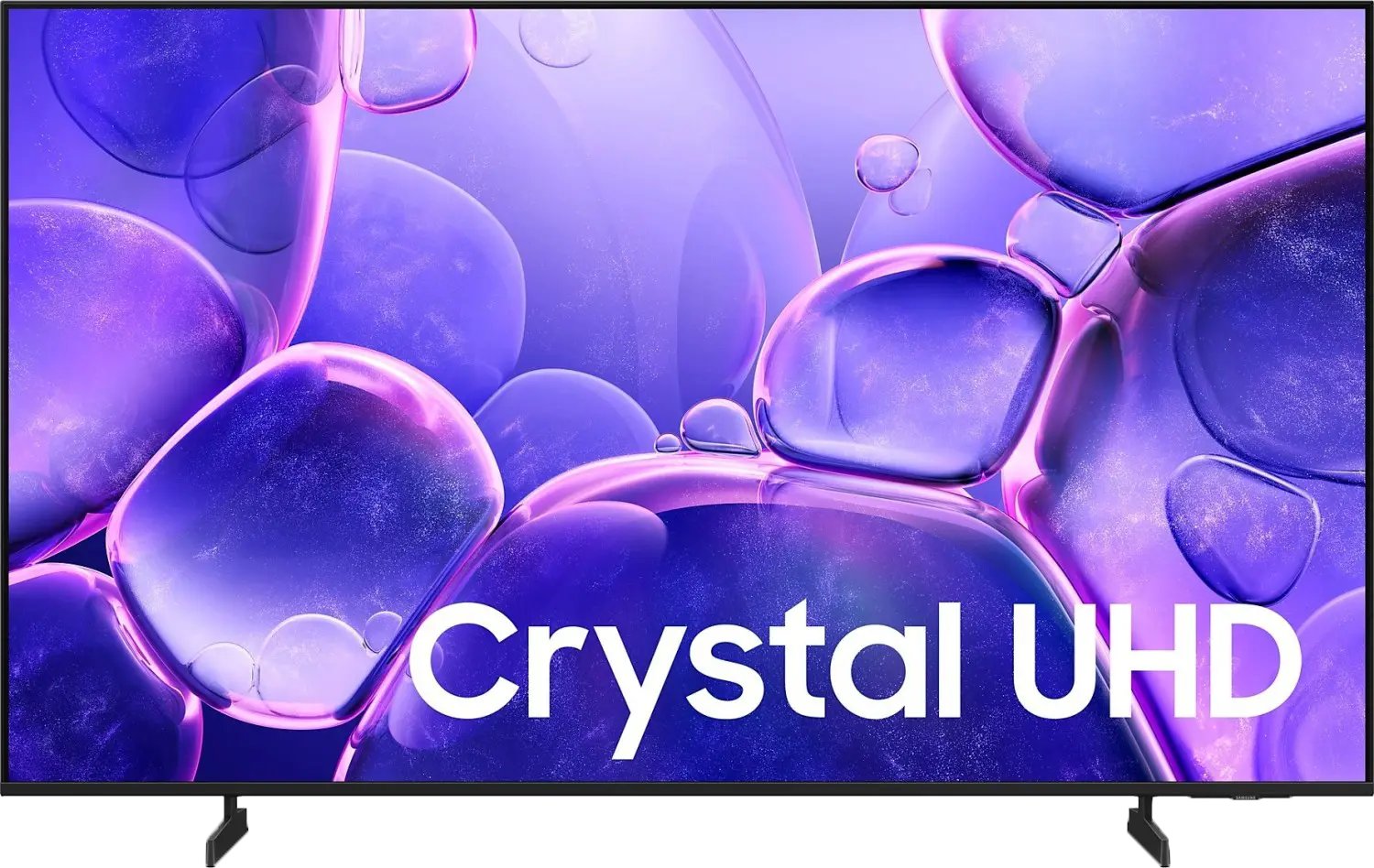
Panel type: LCD VA
Resolution: 3840x2160
System: Titan OS
Model year: 2024
Complete the survey to find out the result

Panel type: LCD IPS
Resolution: 3840x2160
System: Tizen
Model year: 2025
Complete the survey to find out the result

Overall rating
4.6
5.3
Movies and series in UHD quality
4.3
4.8
Classic TV, YouTube
4.9
4.8
Sports broadcasts (TV and apps)
4.5
5.8
Gaming on console
6.2
6.3
TV as a computer monitor
2.0
6.0
Watching in bright light
2.6
3.4
Utility functions
5.0
5.6
Apps
7.0
8.3
Sound quality
5.1
5.7
Complete the survey to find out what fits your preferences
Advantages
Unique Ambilight system
Great smoothness of tonal transitions
Low input lag values
Good built-in file player
Support for DTS sound
Advanced Smart system: Tizen
Good viewing angles (IPS Matrix)
Great for working with text - excellently displays fonts
Low input lag
Basic features for gamers - VRR and ALLM
Disadvantages
Low display brightness
No Dolby Vision
IR remote - requires aiming at the screen
TitanOs system - limited number of apps
Low brightness
Very poor black level and contrast (IPS panel)
Inferior appearance compared to its predecessor
Infrared remote control
Our verdict
The U8000F is a very basic television that may find its buyers among those looking for the cheapest Samsung 4K with Smart TV. And that is exactly its purpose. Thanks to the Tizen system, this model offers quite a bit in terms of smart features – the number of applications and possibilities may catch the attention of those who want a reasonably smart device at the lowest price possible. When it comes to picture quality – it's average, which isn't surprising in this class. Nonetheless, there are a few upsides: quite decent viewing angles will work well for traditional TV viewing from different parts of the room, and the basic features for gamers (like VRR and ALLM) may be enough for typical "Sunday" gamers. The PC mode also deserves a mention – the television handles font display very well, so it can also serve as a cheap monitor. Of course, this is not a model that can be recommended to everyone "sight unseen." But if someone is looking for a cheap Samsung with 4K resolution and a solid Smart system, then the U8000F is just that kind of device.
TV appearance





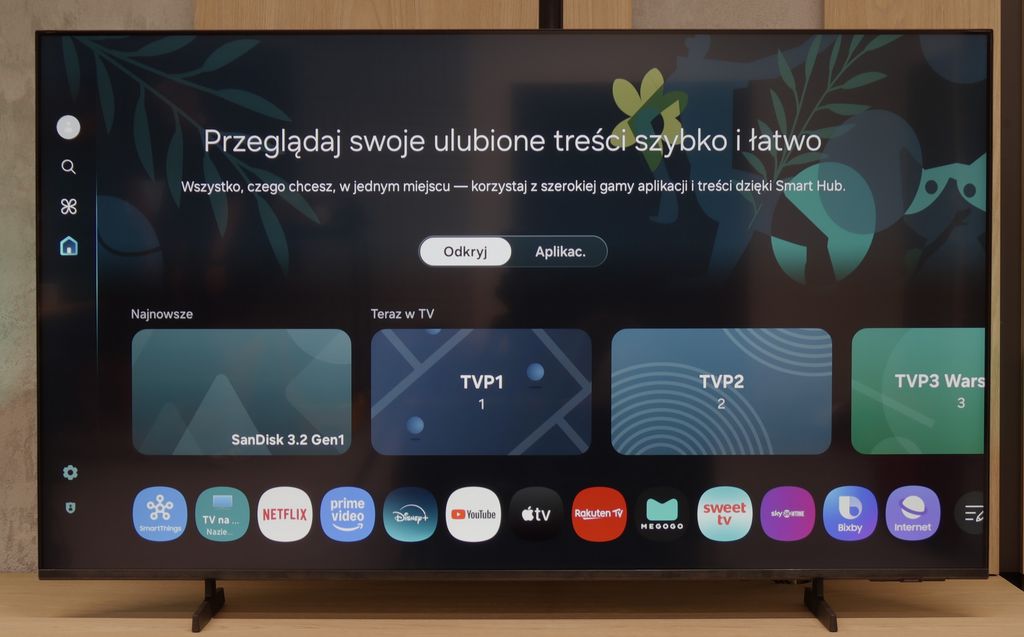
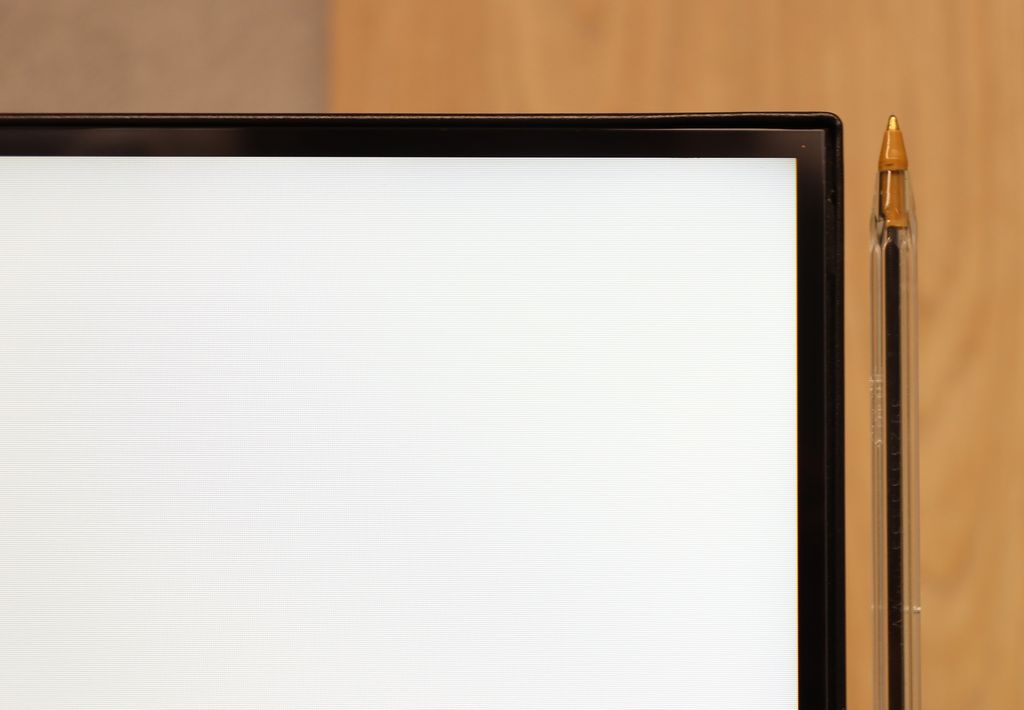

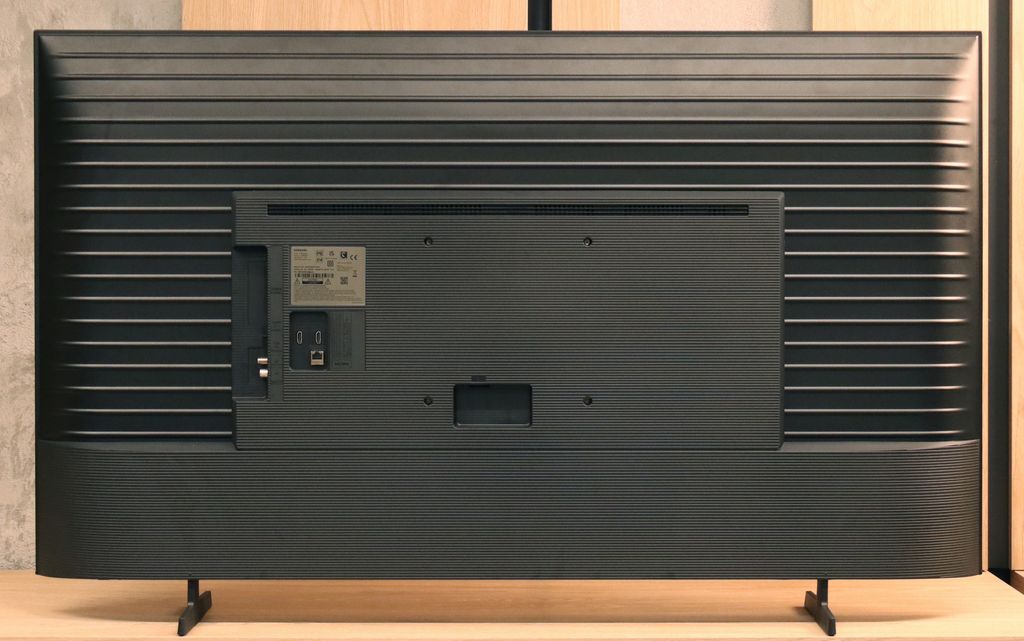
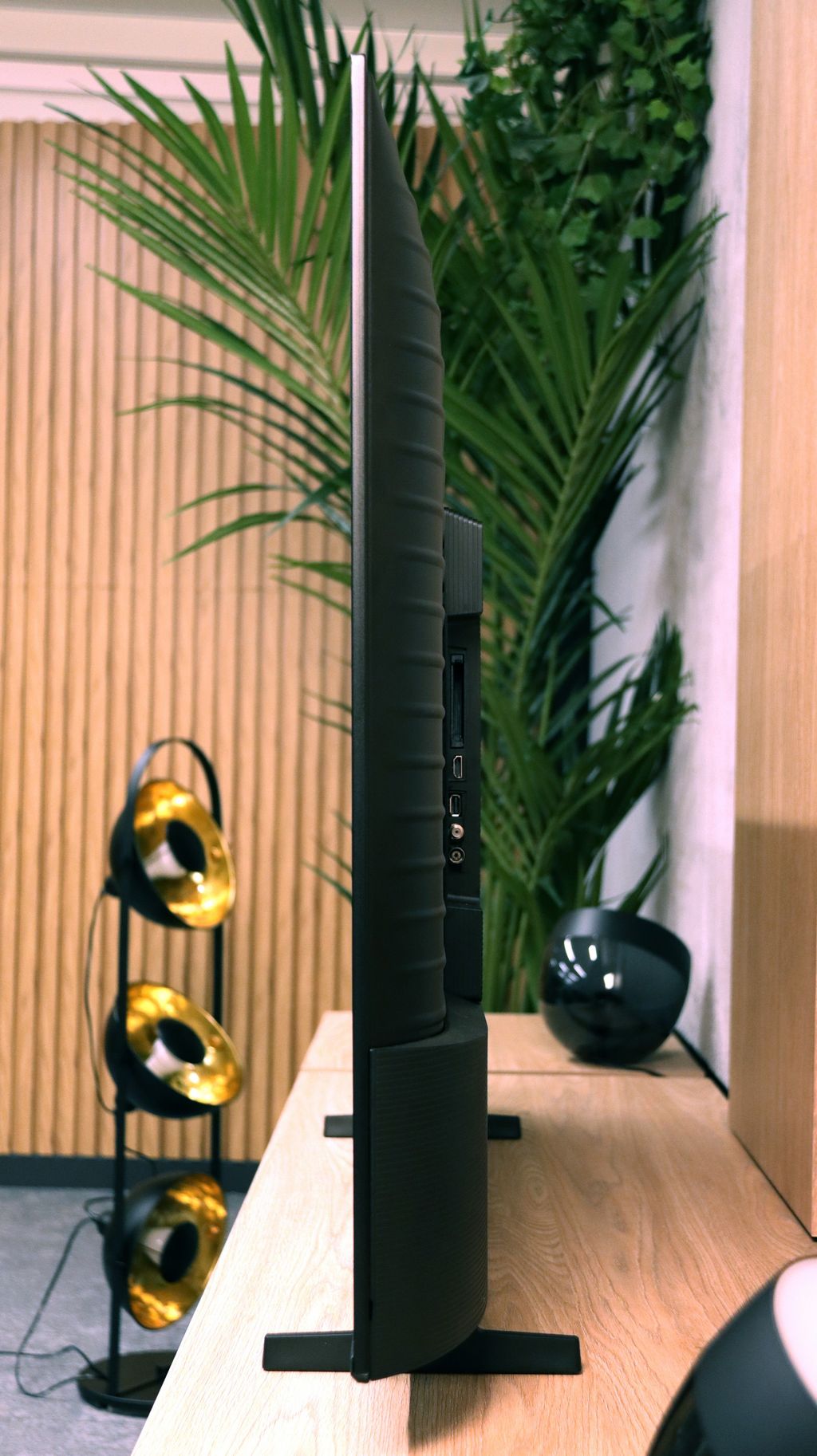
Contrast and black detail
4.3/10
1.1/10
Local dimming function: No
Local dimming function: No
Contrast:

Result
2,750:1

Result
2,550:1

Result
2,150:1

Result
2,350:1

Result
2,350:1

Result
900:1

Result
800:1

Result
700:1

Result
700:1

Result
650:1
Halo effect and black detail visibility:

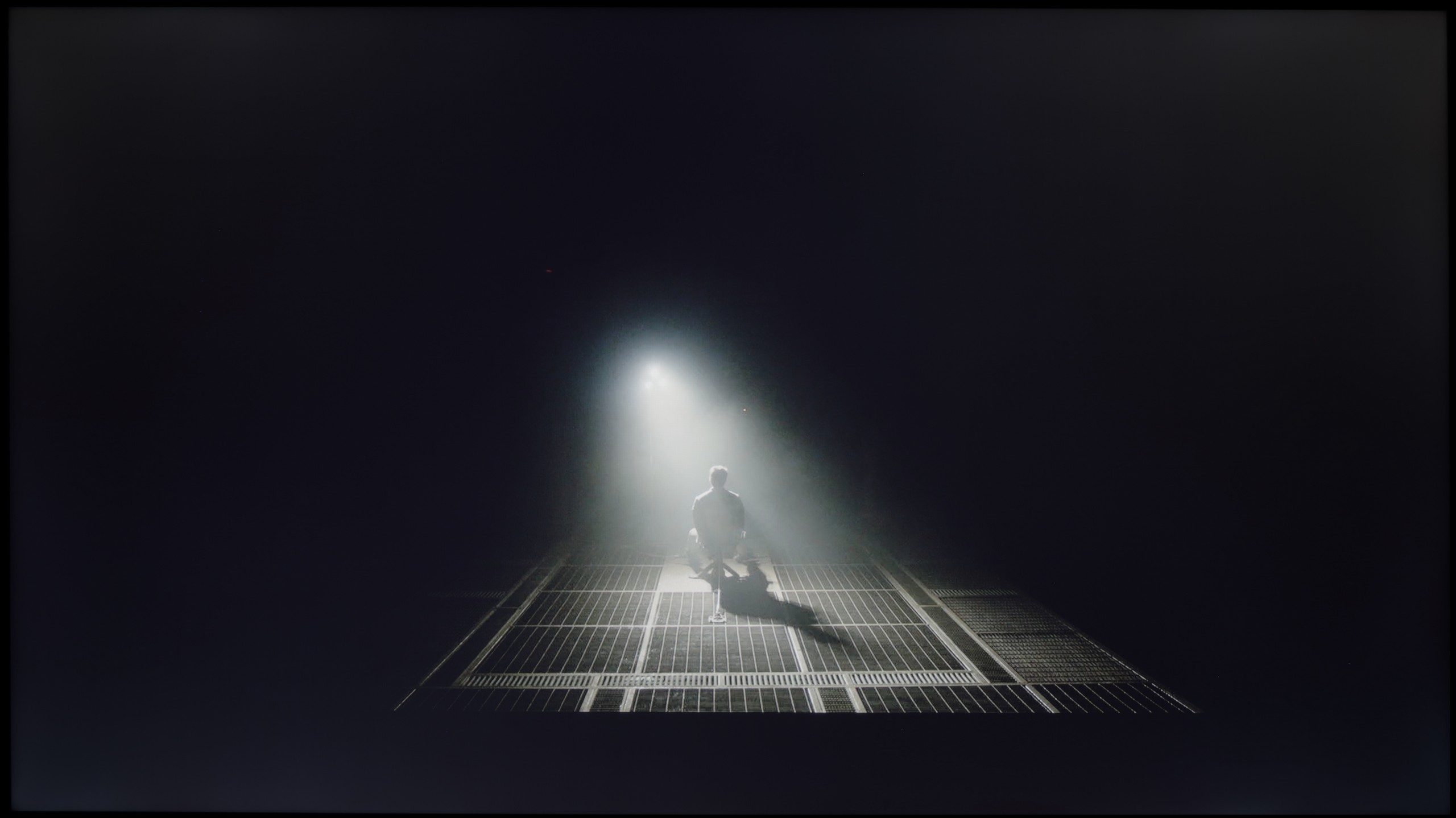
The Philips PUS8079 television is equipped with a VA panel. It’s worth noting that the size we tested is 43", as this manufacturer often changes panels depending on the size. While this type of panel should provide at least decent blacks, since we are dealing with a very budget unit, the results are rather predictable. Results around 2300:1 are among the lowest for this type of panel. More advanced units achieve results 2-3 times better in this regard. However, the current state of affairs shouldn't overly surprise us, as we are dealing with a very, very budget device. We should also mention that in this case, we have direct backlighting (Direct), the only plus of which is the uniformity of lighting. Unfortunately, it has not been divided into any zones, which is not surprising given the low class of the device. On the positive side, we can note the light separation in the test from the movie "Oblivion".
Samsung U8000F, or more precisely the U8092F model in the 55-inch version, is equipped with an IPS panel. Let’s be honest – this is not the best choice when it comes to properly displaying blacks and contrast. The results in this category are simply poor. The contrast is abysmal, and watching dark scenes with any kind of “cinematic” effect is nearly impossible. Additionally, the fact that the TV lacks local dimming doesn’t help, making it difficult to achieve better results. The only thing that deserves praise is the quite decent uniformity of the panel – but that’s more of a minor consolation. Overall, it’s not good. If you care about deep blacks and reasonable contrast, it’s definitely better to go for a variant with a VA panel, which performs significantly better in this particular series.
HDR effect quality
2.7/10
2.7/10
Luminance measurements in HDR:

Result
179 nit

Result
177 nit

Result
202 nit

Result
164 nit

Result
193 nit

Result
191 nit

Result
224 nit

Result
241 nit

Result
79 nit

Result
234 nit
Scene from the movie “Pan” (about 2800 nits)


Scene from the movie “Billy Lynn” (about 1100 nits)


Static HDR10


Dynamic: HDR10+
Dynamic: HDR10+


HDR luminance chart:
Samsung U8000F (IPS)
Luminancja HDR
Luminance of RGB colors
Philips PUS8079
Luminancja HDR
Luminance of RGB colors
The maximum brightness in content with a wide tonal range at 202 nits is extremely low and practically prevents watching movies and series on streaming platforms in the highest quality. It's worth mentioning that in this case, using the HDR format equipped with dynamic metadata won't help either. Why won't it help? Because the only such format implemented in the television is HDR10+, which is extremely unpopular, and films recorded in this format are scarce. It’s also worth noting that PUS8079 uses WLED backlighting, which unfortunately is not the best solution, resulting in coverage of only 80% of the wide DCI-P3 colour gamut. The effect of this reality is significantly less intense colours in HDR content.
Better doesn't mean good – and that's exactly how you can sum up the capabilities of the U8092F when it comes to displaying bright movie scenes in HDR mode. The brightness of the panel is just under 250 nits, which is definitely too low to enjoy any light effects. An interesting situation was observed during measurements of the fourth scene from the movie Sicario 2 – the television clearly dimmed the entire screen in an attempt to achieve better black levels (which still remain weak). One could even suggest that the device employs some form of "global dimming," but unfortunately – the effects are still very poor. To make matters worse, the television does not support a wide colour gamut – the coverage of the DCI-P3 space is around 80%, so don’t count on truly vibrant colours. The HDR image here looks more like slightly brightened SDR, and that’s the approach we would suggest you stick to when it comes to this television.
Factory color reproduction
1.8/10
6.5/10


Factory Mode
After calibration
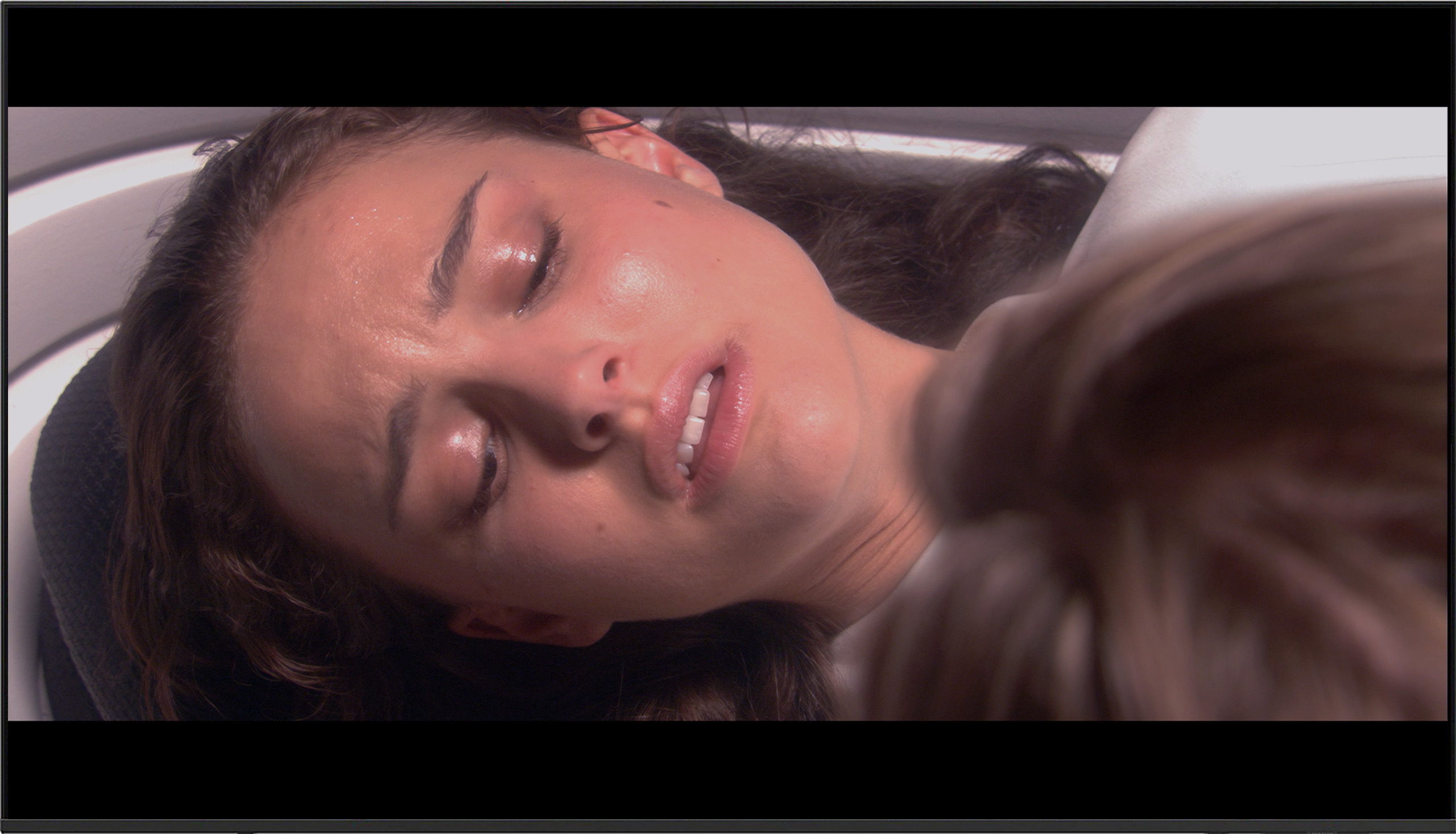
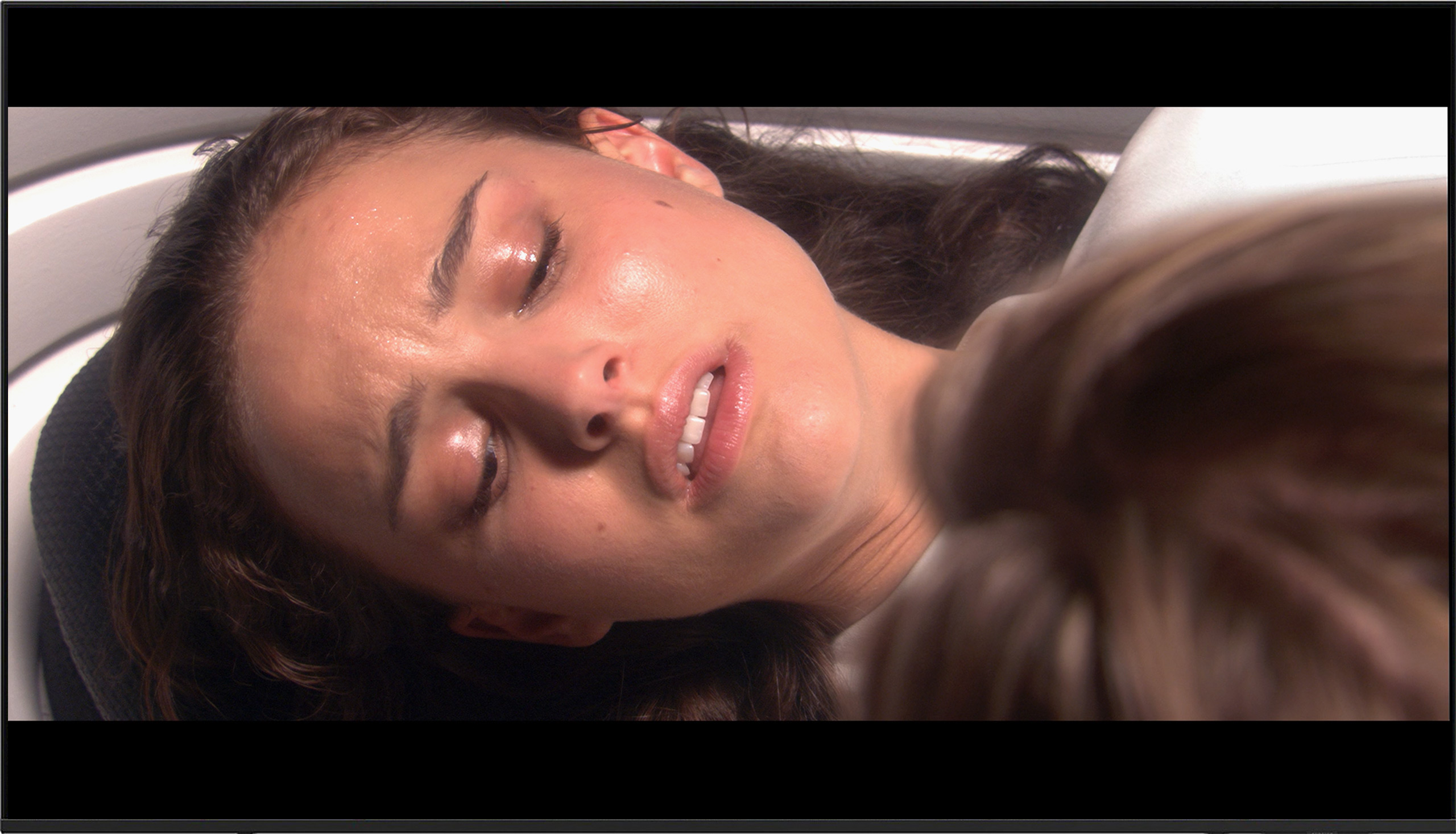
Factory Mode
After calibration
The best factory mode in terms of colour reproduction and fidelity to the director's vision was "Film". While it was the best of the predefined modes, it still had significant discrepancies between what the filmmaker wanted to convey and what the tested television displayed. In both SDR and HDR materials (though to a lesser extent in the latter), the white balance, which is the most fundamental element responsible for image purity, turned out to be somewhat of a repeat of the vibrant mode, with a blue tint reminiscent of what you see in retail displays. Moving directly to the SDR materials and what affects contrast, namely gamma, we see it being severely reduced. This leads to cutting off already minimal contrast resources and brightening the entire image. In the EOTF curve, responsible for the increase in brightness pace in HDR materials, we instead see a strong drop below the reference line, which, given the limited light output of the television, significantly impacted the perception of those contents, which were even more dimmed. We won’t separate the quality assessments of the colours themselves since, in both cases, they achieved astronomical deltaE values, being simply completely different from what they should be.
Samsung U8000F has been tested in the best possible built-in picture mode on the television, which is Filmmaker Mode. This mode should – at least in theory – provide a cinematic, reference image without unnecessary enhancements. For SDR content (mainly HD/SD), the television presented itself surprisingly well out of the box. White balance errors hovered around a value of 3, which is roughly on the edge of perceptibility. The only criticism could be directed at brightness management – the gamma chart showed a slight tendency to brighten or darken certain sections, but overall it performs quite well for this price segment.
Unfortunately, it looks much worse in HDR mode. Although the white balance was not terrible, the television had significant colour errors – particularly evident on the Color Checker chart, where almost every sample fell outside the target point. The image in HDR simply looks unnatural, and the colours can be shifted, muted, or too cool. This largely stems from the fact that U8000F does not support a wide colour gamut (DCI-P3). The television is physically unable to display correct colours in the HDR standard – and this is unfortunately felt in every more demanding material.
Color reproduction after calibration
4.8/10
7.5/10




Luckily, Philips implements advanced image correction tools in all of its TVs. SDR content has benefited the most here, and the huge deltaE errors have been significantly corrected, with both white balance and gamma being substantially reworked. While we can't say it's reference-quality image, it's definitely better, and you can watch a movie or series without causing a headache, especially for your eyes. Naturally, HDR materials, due to the very low luminance of the TV, could not be corrected to the same high degree as those with a standard colour palette, but we managed to roughly straighten out the EOTF curve and the white balance. Unfortunately, that was all we could squeeze out of our unit, although it's worth noting that each unit is different and has entirely different errors, whether minor or major.
Even though the U8000F already offered a fairly good picture in SDR straight out of the box, we managed to tweak it a bit more. We were able to remove a slight purple tint and adjust the gamma to a more reasonable level. However, the television still tends to over-brighten the smallest and brightest parts of the image – the gamma chart shows a characteristic "dip" that is hard to fully straighten out.
Unfortunately, the situation looks worse in HDR. It's difficult to talk about any significant improvement here – the television simply isn't designed for HDR content. We tried to adjust the picture in the advanced settings, but despite our efforts, the colour errors remained quite noticeable – a delta E above 7 is already significantly visible deviations. It's a bit unfortunate, but that's the charm of a budget build. In SDR, the U8000F performs reasonably, whereas HDR is simply not its league.
Smoothness of tonal transitions
7.5/10
9/10












It seems that the fluidity of tonal transitions will be the biggest plus of the tested television. Practically in every scene, they were at a very satisfactory level. The only moments where it is insufficient are around the blacks, but even in these areas, it is quite good, and overall it can still be rated very positively, especially considering the price of the tested device. A matter not related to the fluidity of tonal transitions, but well visible in the photos, is the noticeable backlight bleed in the corners. This is an issue with the artwork itself, but it's worth noting that these cheaper units may be more prone to visible effects.
Another important thing to pay attention to when assessing image quality is the smoothness of tonal transitions – that is, how the television handles blending colours and shades. And here the Samsung U8092F performs... almost perfectly. On the tested images, there are no noticeable banding transitions, no issues with colourful gradients, and the whole picture isn't artificially sharpened, which unfortunately happens with many televisions in this class. The image looks natural and very clear. We noticed minimal problems with the brightest scenes, but that's more of a nitpick that only a very trained eye would catch.
Image scaling and smoothness of tonal transitions
6.3/10
5/10
Smooth transition function

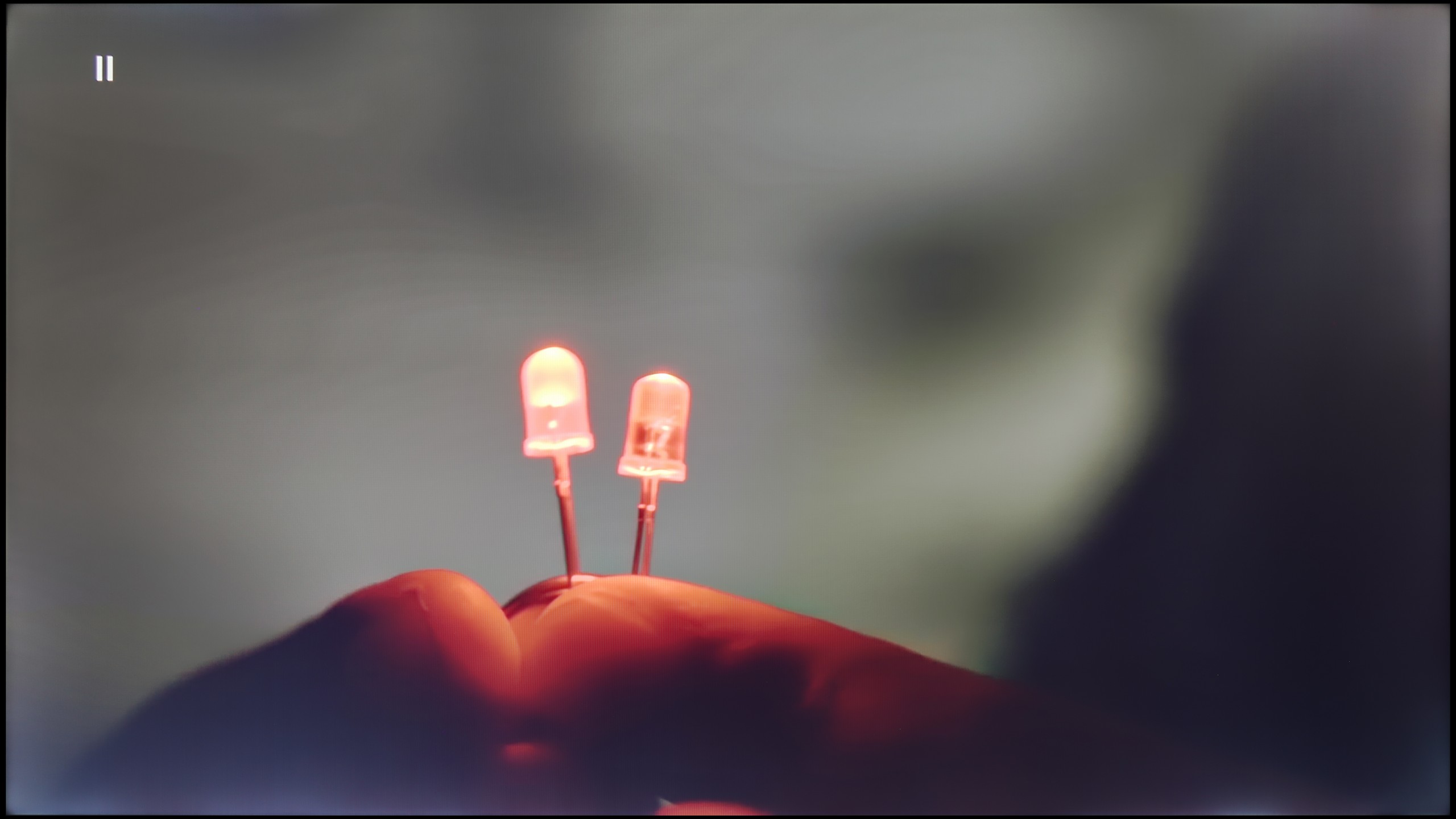
Image without overscan on the SD signal


We will return once again to the issue of tonal transitions, but in the context of overall image quality improvement. As we can observe in the photo on the left, the gradation enhancement feature works brilliantly. Furthermore, it offers several settings, and each of them, even the lowest, provides a beneficial effect, and, what’s more, does not soften the film grain effect. We will repeat once again that this feature is the biggest advantage of the tested television.
Secondly, we will look at image scaling. Here, the tested television performed worse. We can notice, above all, the strongly jagged fine details and the characteristic white glow around figures. We must not forget about the significant artificial sharpening of the image.
When it comes to how the Samsung U8000F handles lower quality materials, we must admit that Samsung has made progress compared to its predecessor from last year – the DU7192 model, which theoretically occupies the same place in the offering.
This year's model has been equipped with a function to improve the smoothness of tonal transitions, which has been implemented significantly better than last year. Yes, the TV still uses quite strong algorithms that can distort details or remove film grain, but even so – it can be confidently said that it operates effectively.
However, not everything has gone perfectly. The U8000F has noticeable issues with slight frame stuttering when watching very old content in very low resolution. If someone plans to play their old VHS tape, they must be aware that the picture may appear slightly "choppy".
Blur and motion smoothness
4.2/10
6/10

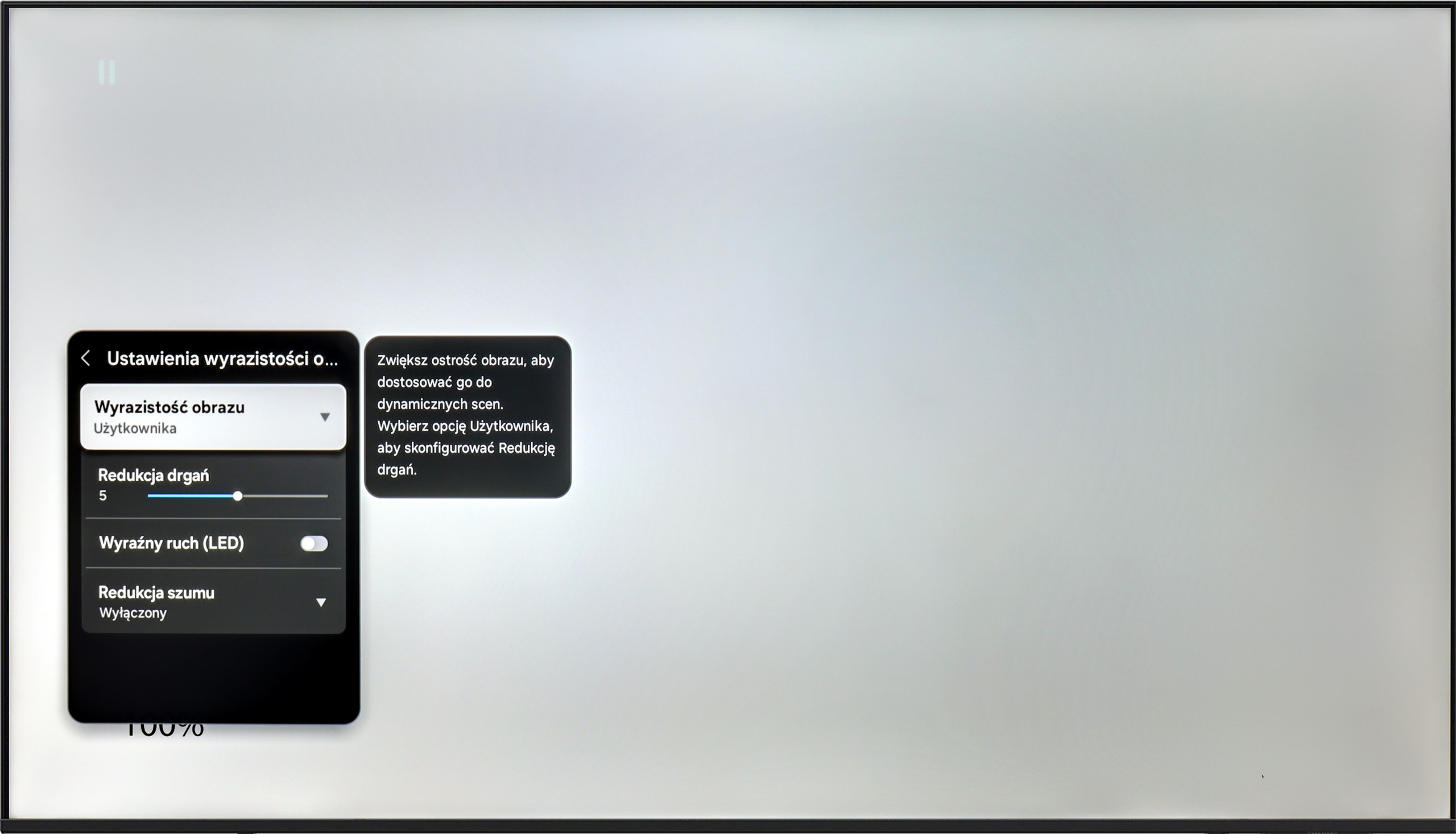
Blur (native resolution, maximum refresh rate):




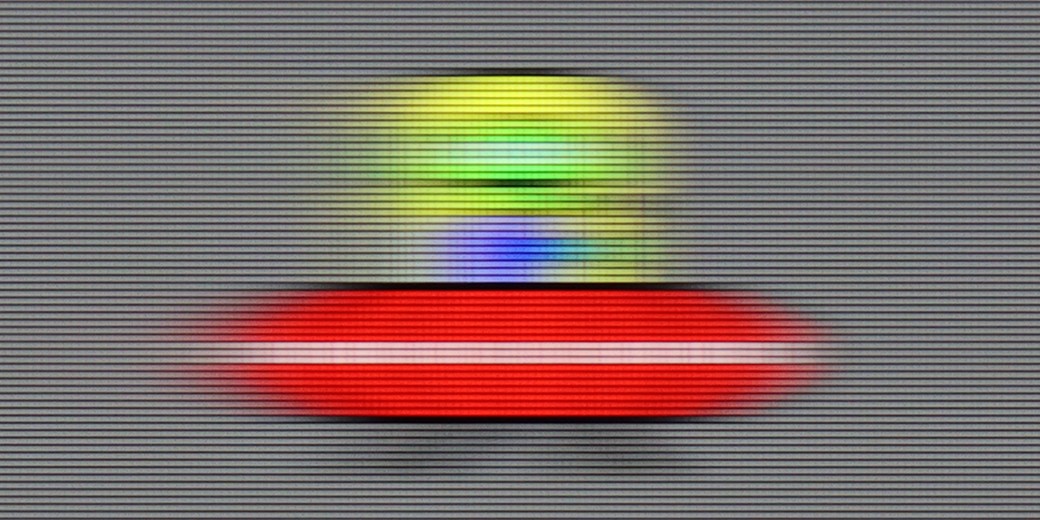

This paragraph, unlike the others, will be extremely short. The reason for this situation is the lack of implementation of even the most basic motion smoothing function, which was to be expected given the price of the device. We also note that we are dealing with a VA panel, whose sharpness will not be the best under the sun. This type of panel is mainly associated with high contrast, which goes hand in hand with a relatively slow response time, as we can clearly read from the panel analysis results. As you can see, from the images captured in quick motion, the picture is blurred, typical for this type of panel. Although it may not be the ideal option, it can conditionally be used for watching sports, although one must keep in mind the less than optimal sharpness in motion. It's worth mentioning that movies will exhibit stuttering, as the television does not have any, not even the simplest, motion smoother.
Samsung U8000F is equipped with a 60 Hz panel, so right from the start, it's clear that we shouldn't expect miracles. This is simply the standard in this class – sufficient for everyday viewing, but without any fireworks.
The television offers one motion smoothing slider – a feature called “Motion Blur Reduction”, which allows us to adjust the smoothness of the image in movies. Higher settings provide a more “theatrical” and smoothed effect, while lower ones maintain the original character of the film with a slight 24p effect. An interesting feature is “Clear Motion LED”, or BFI mode – which inserts black frames between the image frames to enhance motion clarity. However, in practice, the screen flickers significantly when it's activated, and it's better viewed as an experiment rather than something that truly enhances gaming comfort.
Console compatibility and gaming features
4.7/10
4/10
- ALLM
- VRR
- VRR range48 - 60Hz48 - 60Hz
- Dolby Vision Game Mode
- Correct implementation of HGIG
- 1080p@120Hz
- 1440p@120Hz
- 4K@120Hz
- Game bar

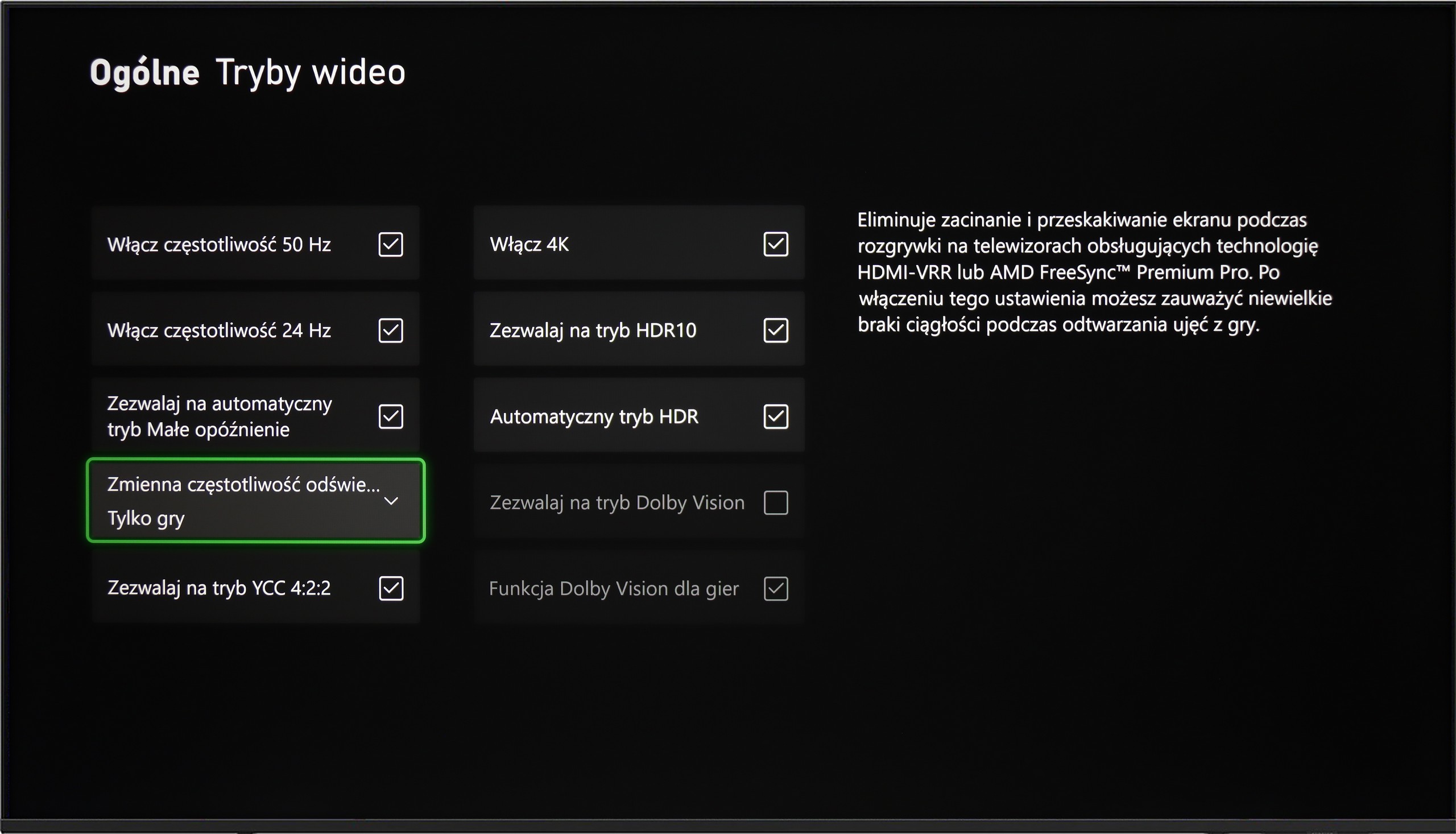



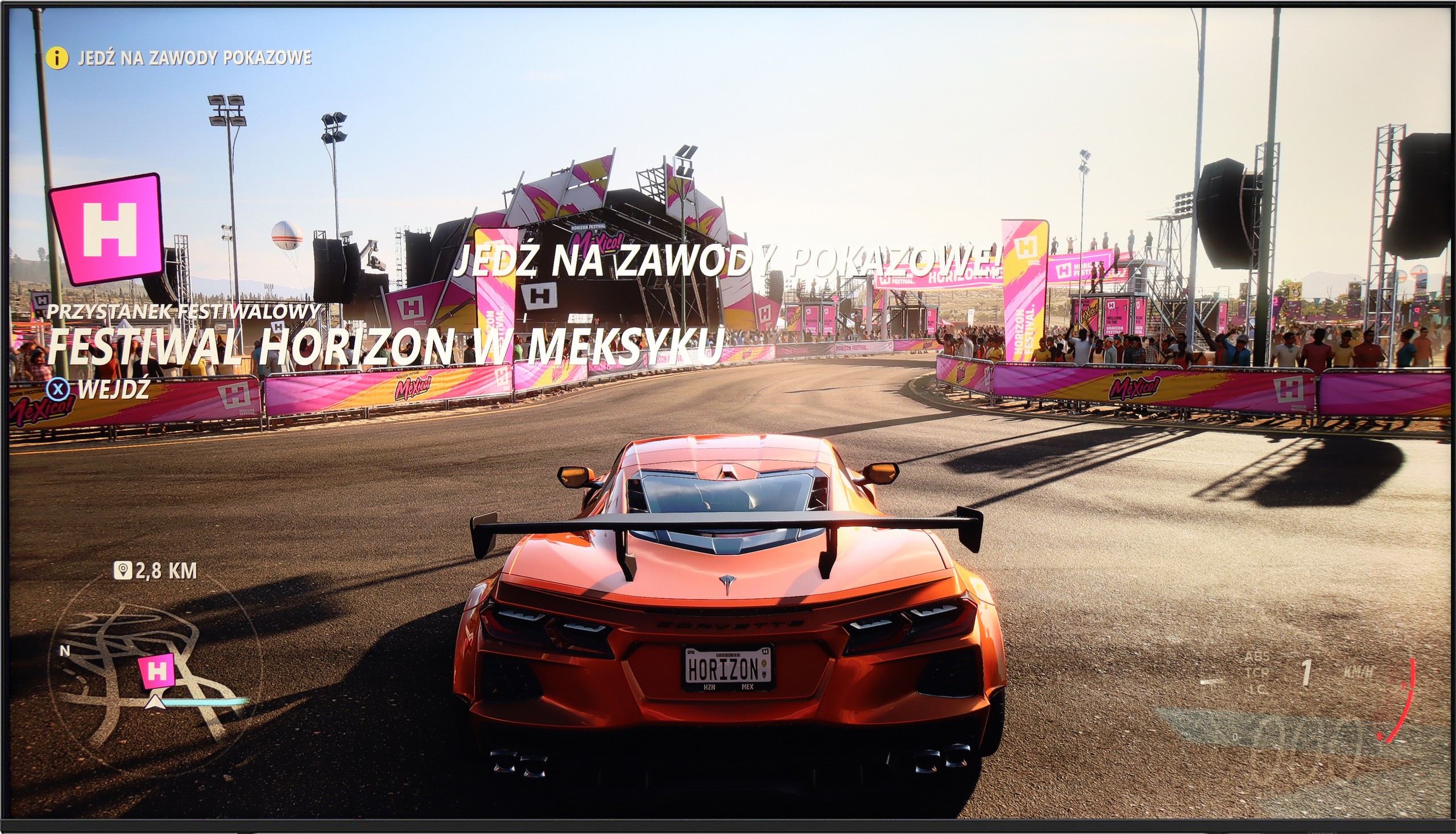


Philips PUS8079 offers only the most basic support for gaming in the form of ALLM, VRR, and Game Bar. The most important information is that thanks to the implementation of the feature responsible for dynamic refresh rate adjustment, the image is actually quite smooth for this price range and does not 'tear' the image.
A slightly greater nod towards gamers is the introduction of the Game Bar, allowing for settings adjustments 'on the fly'. This means we won’t have to exit the game to make any changes to the image. Importantly, it hasn’t been stripped of options known from higher models. We can find features such as shadow enhancement for better visibility in shadows and a colour filter for players with visual impairments.
Samsung U8000F offers a basic set of features for gamers, which may still be sufficient for less demanding users. It has an automatic game mode – when a game is launched on the console, the TV automatically switches to low latency mode, which significantly improves response time. It also includes a VRR function, or variable refresh rate, which works within the range of 48 to 60 Hz. This means that both Xbox and PS5 won't produce the "tearing" effect – as long as we stay within this range.
And unfortunately, that's about it for the advantages. Additional features like Game Bar or higher refresh rates are reserved for higher models of Samsung’s 2025 line. In theory, the TV also supports the HGiG function, which should adjust the HDR image to the intentions of game developers. Unfortunately – although this function appears in brochures and store materials – its setup on the Xbox console turned out to be... impossible in practice.
Input lag
9.9/10
10/10
SDR
HDR
Dolby Vision
Results of input lag measurements in Philips PUS8079 stand at a high level, regardless of the signal or resolution. All gamers will undoubtedly appreciate the efforts of the manufacturer, which allow a game running at 4K60Hz with HDR to have only 13 ms of lag, which is virtually unnoticeable even in online games.
The Samsung U8092F performed phenomenally well in our input lag tests. Regardless of resolution or mode – the results were very low, which is quite impressive for this price segment. Therefore, it’s safe to say that gaming on this TV will not cause frustration due to significant delays between what we do on the controller and what we see on the screen. For most gamers, even the more demanding ones, this result should be more than satisfactory.
Compatibility with PC
2/10
6/10

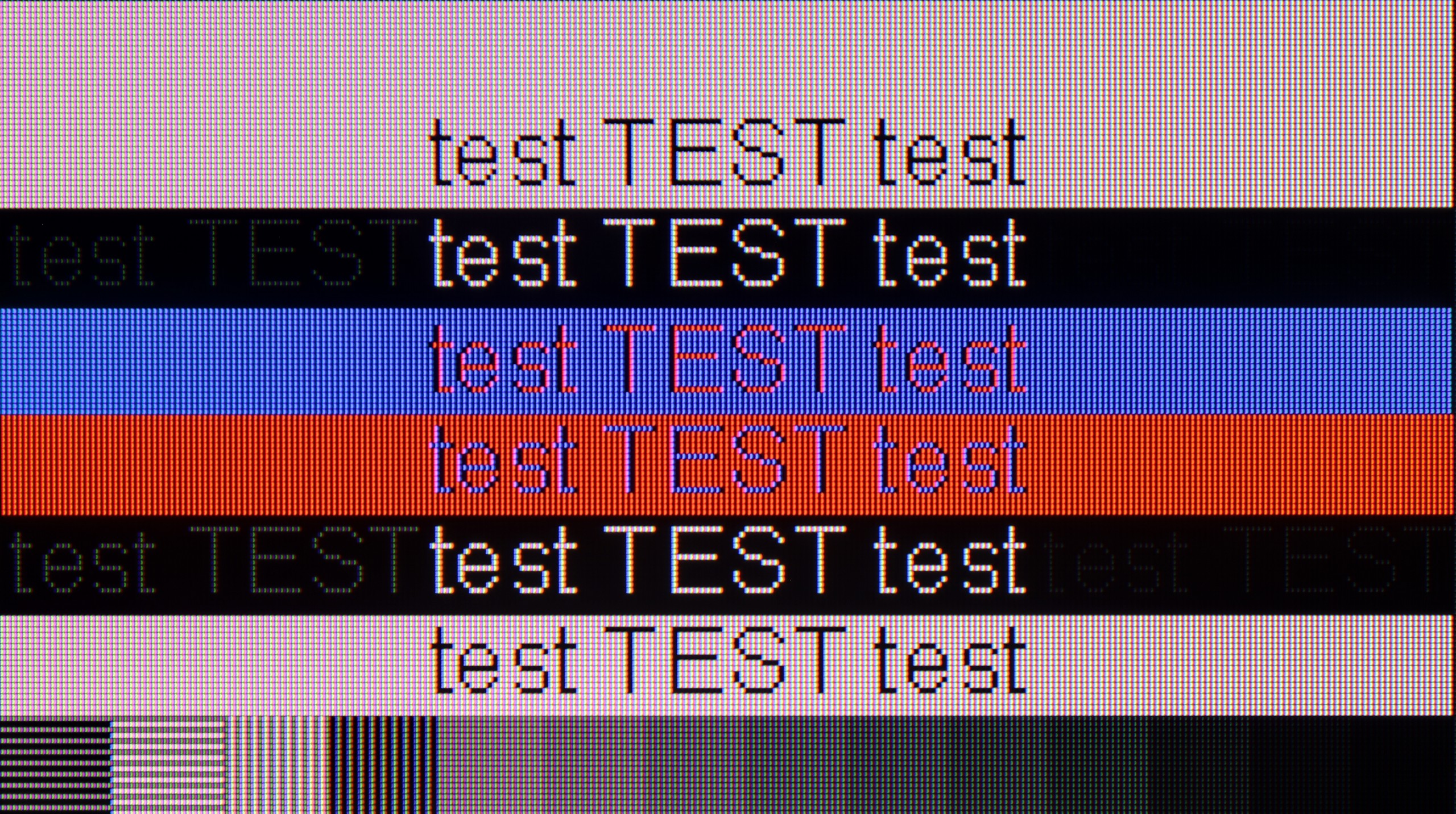
After connecting the television to the computer and wanting to use it as a monitor, we can expect a low input lag of 14 ms, which is practically unnoticeable on the mouse-screen-eye line. Unfortunately, the readability of the fonts is at a very low level, which practically excludes the use of Philips PUS8079 as a monitor. Why? If you look closely at the photo of the grey text, you'll notice a phenomenon called dithering. It is clearly visible that not all subpixels are lit up on the adjacent pixels, whereas all should be active when displaying grey. Therefore, the text will be annoyingly blurry, effectively hindering work.
Working on the computer using this television is a real pleasure. The Samsung U8092F supports chroma 4:4:4, and thanks to the arrangement of the sub-pixels in the IPS panel, the readability of fonts – regardless of colour or size – is very, very good. The television is also suitable for occasional gaming on PC, mainly due to the low input lag. However, one must keep in mind that the G-Sync feature does not work on this model, which is strange because VRR worked without any issues when it came to the console.
Viewing angles
3.8/10
7/10
The biggest and most common flaw of VA panels is their viewing angles. This is particularly true for units lacking angle coatings, which would make a significant difference in this regard. Interestingly, the tested unit performed considerably better than, for example, the PML9009 we recently checked. Nevertheless, even a slight shift off-axis results in a strong degradation of colours and a drop in contrast.
The viewing angles on the Samsung U8092F are very good – as is typical for an IPS panel. The image doesn’t lose much in terms of brightness or colour saturation, even with a greater deviation from the axis. Of course, it’s not on the level of organic screens – but it’s entirely sufficient for comfortably watching the image at an angle, for example, from the side of the couch.
TV efficiency during daytime
2.6/10
3.4/10

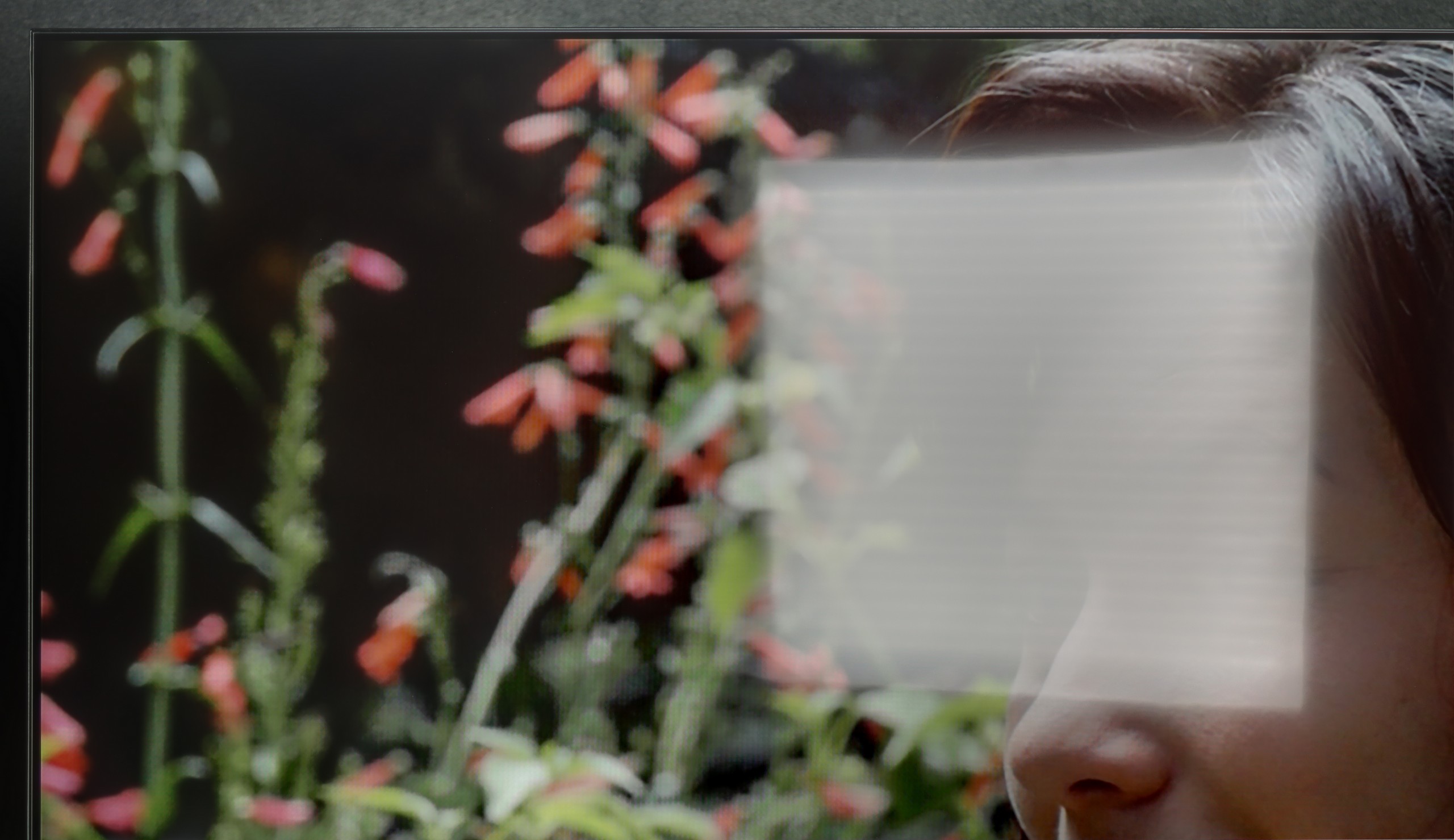

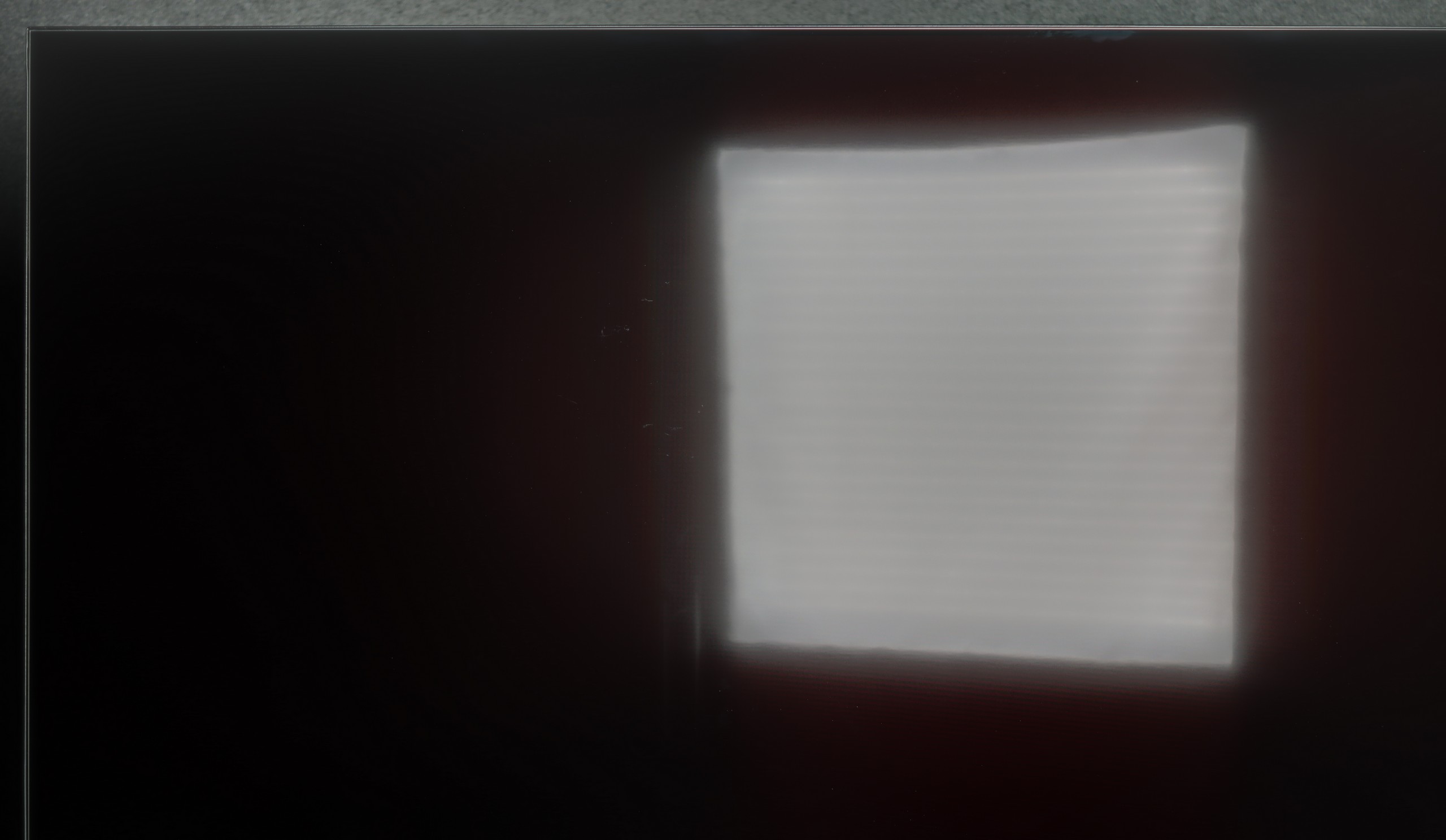
Matrix brightness
Average luminance SDR
Samsung U8000F (IPS): 218 cd/m2
Philips PUS8079: 192 cd/m2
In our test sequence, there was also a place to check the performance of the television during daytime viewing. In fact, we also suggest this operational scenario, considering the insufficient contrast. Returning to the point: the use of a satin finish yielded poor results, which, combined with the low luminance of the television across all models, effectively disqualifies it for viewing in a sunny room.
Thanks to the satin coating of the Samsung U8092F display, it handles reflections quite well. The screen doesn’t act like a mirror, and the colours – for a device of this class – remain fairly saturated, even in somewhat brighter conditions. Unfortunately, the coating alone can’t work miracles. The TV is just too dark to effectively shine through very challenging lighting conditions. If we place it opposite a light source (e.g. a large window or a strong lamp) – unfortunately, we need to accept that not everything will be clearly visible on it.
Details about the matrix
Subpixel Structure:

Panel uniformity:


Philips PUS8079
Samsung U8000F (IPS)
TV features
5/10
5.6/10
- HDMI inputs3 x HDMI 2.0, 0 x HDMI 2.13 x HDMI 2.0, 0 x HDMI 2.1
- OutputseARC (HDMI), ARC (HDMI), Mini-Jack (Headphones)eARC (HDMI), ARC (HDMI)
- Network InterfacesWi-Fi 2.4GHz, Wi-Fi 5GHz, Ethernet (LAN) 100MbpsWi-Fi 2.4GHz, Wi-Fi 5GHz, Ethernet (LAN) 100Mbps
- TV receptionDVB-T, DVB-T2, DVB-S, DVB-S2, DVB-CDVB-T, DVB-T2, DVB-S, DVB-S2, DVB-C
Classic features:
- Recording to USB (terrestrial TV)
- Recording programming
- Picture in Picture (PiP)
- RF remote control (no need to aim at the screen)
- Backlit remote control
- Teletext
- Audio only mode
- Possibility to connect Bluetooth headphones to the TV
- Possibility to simultaneously use Bluetooth headphones and the TV speaker
Smart features:
- AirPlay
- Screen mirroring (Windows Miracast)
- Wyszukiwanie głosowe
- Voice search in native language
- Ability to connect a keyboard and mouse


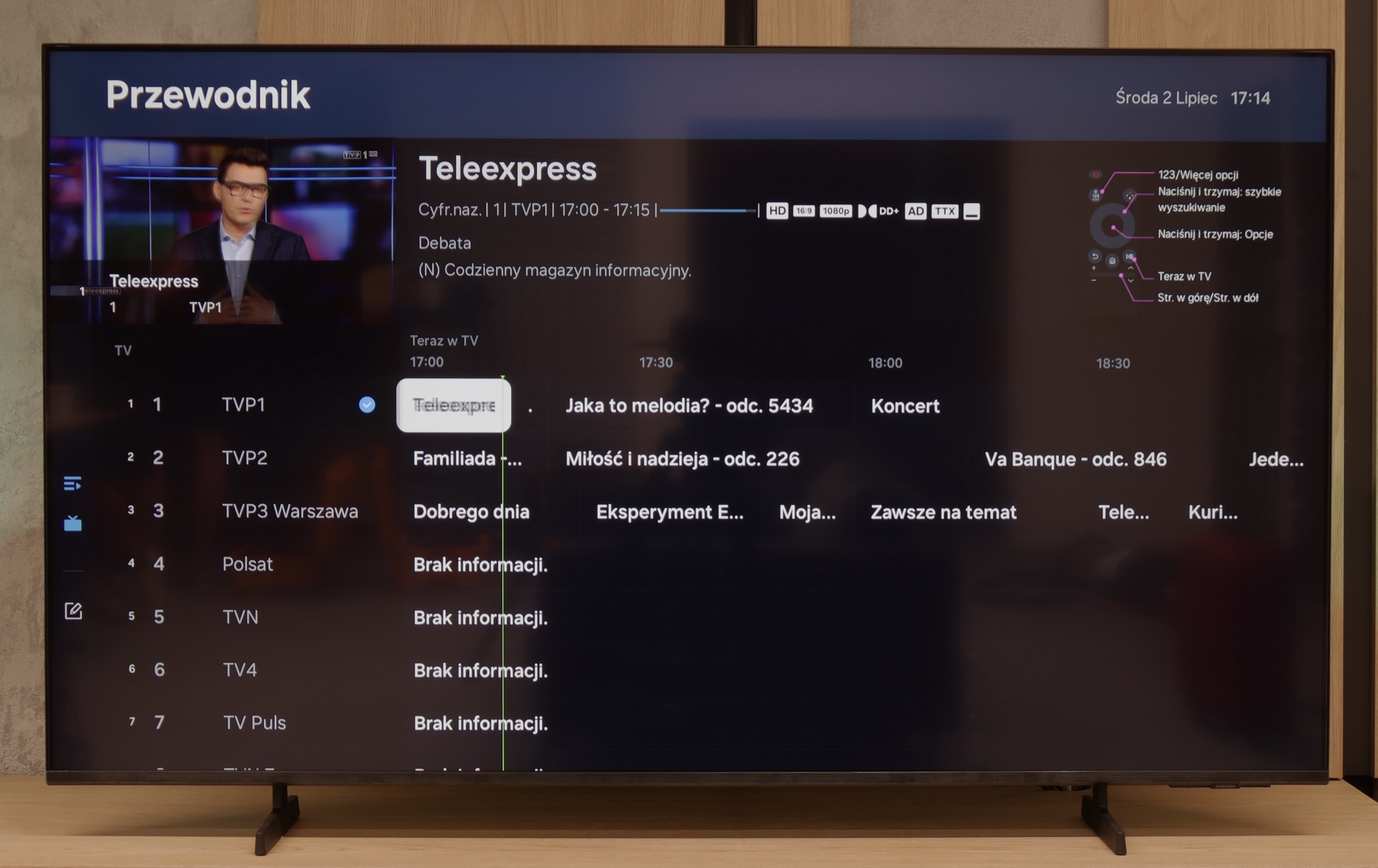

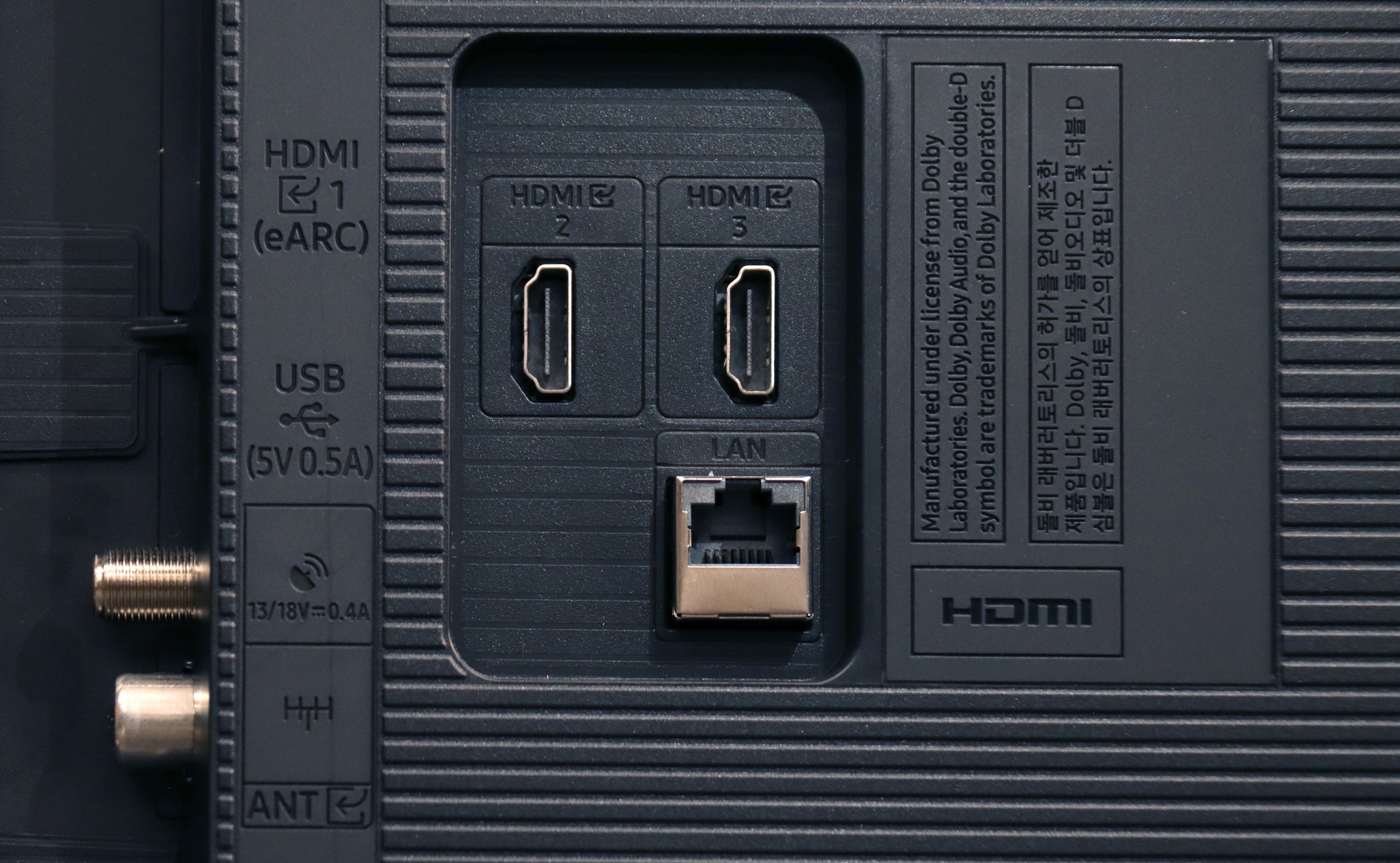
One cannot fail to mention the biggest distinguishing feature of the manufacturer's televisions. We are, of course, talking about the multicoloured Ambilight backlighting, which is placed on the back of the device and displays colours adjusted to what is happening on the screen, often allowing for an even greater immersive experience. The operating system responsible for the television's functioning is Philips' proprietary system charmingly named TitanOs. It is definitely more closed and limited in terms of application resources than the televisions from this manufacturer that are based on the GoogleTV system. Besides the lack of important applications, its closed nature also manifests itself in another way. We won't be able to do such basic things as scheduling recordings or recording to USB. Those using devices from Apple may also feel disappointed by the absence of AirPlay functionality, which allows for easy screen streaming. Fortunately, there is an option to connect a keyboard and mouse for smoother navigation through the television menu. It is worth mentioning that there is an option to connect headphones, but only wired ones. If we connect them, we can also play sound through the television's speakers. It is also worth adding that the control of the television is done over IR, rather than Bluetooth, which is quite inconvenient in these times.
In summary: TitanOs has quite a few "buts," especially when we are conscious users needing and using many streaming platforms. It is rather an option for those limiting themselves to the so-called holy trinity, namely Netflix, YouTube, and CDA.
Samsung U8092F – like all this year's models from this brand – runs on the Tizen operating system. The system itself is really well developed: we have access to many applications (although not all), a well-developed smart home support, and various additions, including exclusive Samsung applications. Features such as AirPlay and Chromecast are also included, allowing us to easily connect our phone to the TV and stream multimedia.
Unfortunately, as this is Samsung's cheapest series in 2025, the manufacturer did not decide to include a solar remote. In the package, we find a classic infrared remote that visually resembles a newer version, but unfortunately lacks voice functions. When it comes to typical "TV" features – it misses recording functionality and the PiP (picture-in-picture) mode. On the positive side, though, the HDMI eARC works well, allowing for easy control of the included remote with devices like a decoder or soundbar – and it really works seamlessly.
Playing files from USB
8/10
8.7/10
Supported photo formats:
Maximum photo resolution:

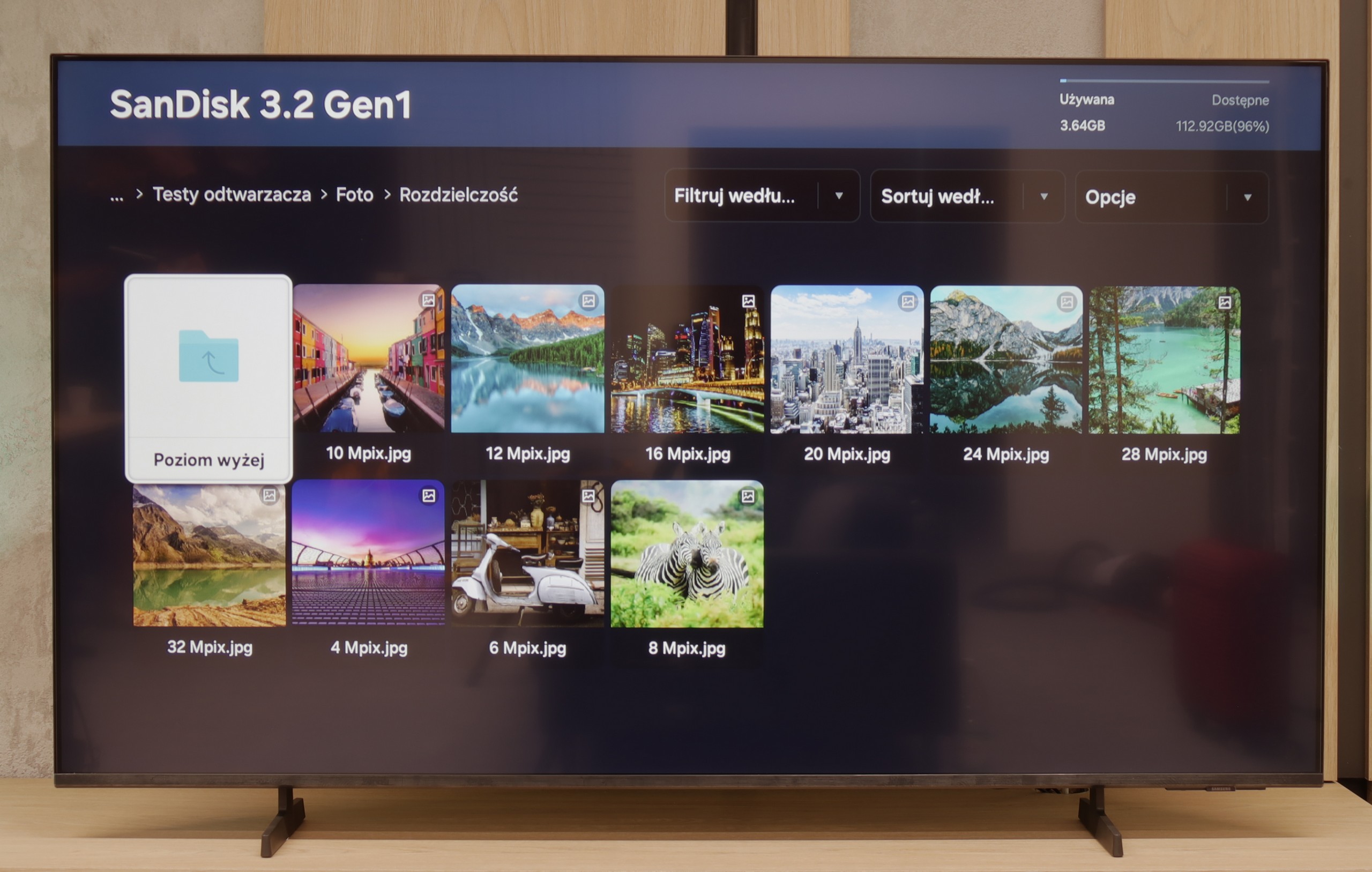
The default media player built into Philips PUS8079 offers quite a wide range of features but also has its limitations. It plays practically all video formats, with the obvious exception of Dolby Vision and the less obvious .asf, which is not commonly encountered. However, there are issues such as the lack of support for the H.265 HEVC codec at high bitrate and handling of .sub files, which are fairly popular. When it comes to photos, the player performs adequately, but it lacks support for some popular resolutions and formats, such as HEIC, used on Apple devices. The player performs best with audio, where it can't be faulted. Unfortunately, due to system limitations, there is no option to expand its features, meaning we are left with what the manufacturer has provided.
Samsung U8092F handles playback of files quite smoothly – the television supports most popular audio and video formats. Of course, it doesn’t support Dolby Vision, but you simply won’t find that in any Samsung model.
There are some reservations regarding the support for external text files – the ones that users would like to add as subtitles to a film. During our tests, the television only played TXT files, and other extensions like SRT or SUB unfortunately did not work. This may not be an issue for everyone, but it’s worth knowing. Perhaps this is a problem to be improved in the future with a software update for the television.
Apps
7/10
8.3/10














































Sound
5.1/10
5.7/10
- Subjective sound quality:5.1/105.7/10
- Dolby Digital Plus 7.1:
- Dolby True HD 7.1:
- Dolby Atmos in Dolby Digital Plus (JOC):
- Dolby Atmos in Dolby True HD:
- DTS:X in DTS-HD MA:
- DTS-HD Master Audio:
The best thing that can be said about the sound system in Philips PUS8079 is that it is present. There is practically a lack of mid-tones and bass. Meanwhile, the high tones stand out in a rather unpleasant way. Interestingly, we find a complete set of the most important audio codecs here, including Dolby Atmos and DTS-HD Master Audio. Because of this, connecting our home theatre system will be merely a formality.
U8092F doesn't pretend to have a home theatre on board. We get the standard set of 2 x 10 W, which sounds fine but lacks excitement, albeit with a bit of bass. For everyday viewing, this audio setup is more than adequate. We were pleasantly surprised that it managed to play a movie with the built-in Dolby Atmos (JOC) codec – though of course, we're not talking about true surround sound here.


